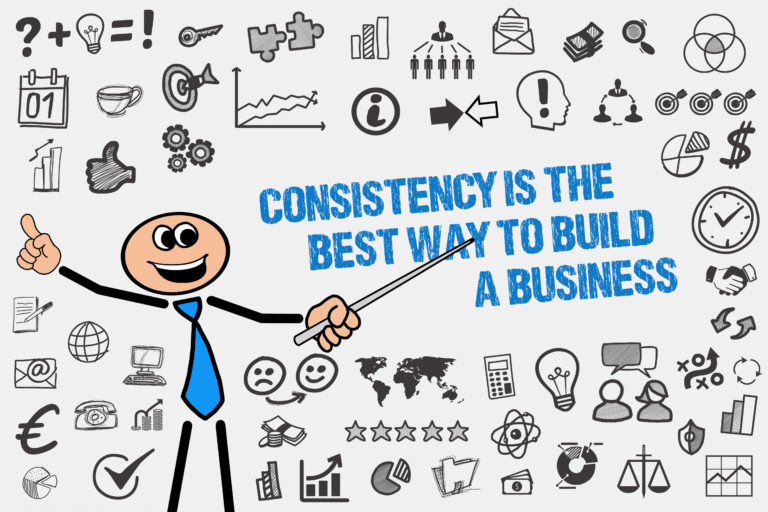The Role of Consistency in Enhancing Satisfaction and Revenue

Consistency refers to the effort of aligning all services to ensure uniformity across different settings. It is crucial for promoting the same message and delivering the same level of service to all customers. The customer’s experience should be consistently satisfactory, regardless of location or time. For instance, an IKEA customer in the United States should receive the same level of service as one in Europe. Maintaining high standards of customer satisfaction is vital for the sustainability of all branches.
Negative experiences can impact not just a single branch or department but potentially the entire network of stores or departments. This is particularly crucial for small businesses, as consistency provides them a solid foundation to manage situations that could affect service quality.
In marketing, for example, it’s vital to ensure a consistent experience at all customer touchpoints. The process of marketing to potential customers must be seamless, maintaining a high standard at every point of contact.
To achieve this level of control, businesses must focus on maintaining strict consistency in their messaging, services, and even their physical appearance.
Consistency and Emotional Bonding

Emotions often reflect external stimuli. As a small business, if you can control the stimuli your customers receive, you effectively manage the consistency of emotions.
Emotions can be key in establishing strong bonds between businesses and customers. For instance, a company can manage customers’ expectations and emotions, preventing negative experiences through proactive control of situations.
A powerful strategy to influence the emotions that a brand elicits in consumers is through the humanization of the brand. This strategy involves assigning human characteristics to a brand, allowing customers to relate better to the brand’s message and intentions, thereby fostering bonding and loyalty.
Consistency and emotional engagement can provide a solid foundation to control a customer’s experience when visiting your store, whether it’s a brick-and-mortar shop or an e-commerce platform. Regardless of location or time, consistency sets the tone to effectively communicate exactly what a brand wants its customers to hear, see, and feel.
Building Consistency in Small Businesses or Sole Proprietorships
1. Develop Clear Communication Channels
Even in a small business with a single employee, communication is still crucial. In this case, it refers to communication with customers, vendors, and other external stakeholders. Developing clear and consistent communication channels can help ensure that the messages conveyed are aligned with your brand and service standards. Use templates for emails, standard scripts for calls, or pre-set responses for common inquiries to help maintain this consistency.
- Adopt Simple Feedback Mechanisms
Feedback remains a vital tool for growth and improvement. Implement simple, efficient mechanisms to gather customer feedback. This could be as straightforward as a quick survey at the end of a service or a feedback form via email. Pay close attention to this feedback and use it to make necessary service adjustments.
Even in a one-person operation, having documented procedures helps ensure consistency and quality. Write down the steps for each critical task in your business operation. These SOPs can serve as a checklist, helping you to deliver a consistent service experience. They can also be beneficial if you plan to expand or need to onboard new staff in the future.
- Monitor Your Progress
Track your progress to identify areas for improvement. For small businesses, this might be as simple as tracking customer reviews or repeat business. Set specific goals for key areas of your business and monitor your progress towards these goals. If you notice any inconsistencies, take the time to identify the root cause and make the necessary changes to your processes.

Leveraging Technology for Consistency and Efficiency
In the modern business landscape, technology is a key enabler of consistency, especially for small businesses. There are numerous tools and software applications available that can help streamline operations, improve efficiency, and maintain consistency in your service delivery.
-
Communication Tools: Tools like Slack, Microsoft Teams, or Google Workspace can keep all your business communication in one place, ensuring consistent messaging and timely responses. These tools also support video conferencing, which can be useful for meeting with clients or vendors.
-
Project Management Tools: For task management and workflow organization, tools like Trello, Asana, or Monday.com can be incredibly helpful. These tools allow you to track progress, assign tasks, and manage projects from a single dashboard, ensuring all work is completed consistently and on time.
-
Customer Relationship Management (CRM) Systems: CRMs like Salesforce, HubSpot, or Zoho CRM can help you manage customer data, track interactions, and provide consistent customer service. These systems can also automate certain tasks like follow-up emails or reminders for customer check-ins.
-
Social Media Management Tools: If your business has a presence on multiple social media platforms, management tools like Hootsuite, Buffer, or Sprout Social can help you schedule posts, manage engagement, and maintain a consistent brand voice across all platforms.
-
E-commerce Platforms: If you’re selling products or services online, platforms like Zona Shoppers, WooCommerce, or BigCommerce can provide a consistent, user-friendly shopping experience for your customers.
By leveraging these technologies, you can create a consistent operational framework for your small business. This will help ensure that no matter where or when a customer interacts with your business, they will receive the same high level of service, enhancing their overall experience and encouraging loyalty to your brand.
Building a Strong Online Presence for Consistency and Branding
In today’s digital age, having a strong online presence is crucial for small businesses to maintain consistency in their branding and effectively reach their target audience. Here are some key aspects to consider:
-
Consistent Branding: Establishing a consistent brand identity across all online platforms is essential. This includes using consistent logos, colors, fonts, and tone of voice in your website, social media profiles, and other online communications. This visual and verbal consistency helps customers recognize and remember your brand.
-
Website Optimization: Ensure your business website is user-friendly, visually appealing, and consistent with your brand image. Make sure your website is responsive and accessible on different devices. Provide consistent and up-to-date information about your products, services, and contact details. Implement clear calls-to-action to guide visitors towards desired actions.
-
Social Media Engagement: Select social media platforms that align with your target audience and industry. Maintain consistent branding across your social media profiles, including profile pictures, cover photos, and bio descriptions. Regularly post relevant and engaging content that reflects your brand voice and values. Engage with your followers, respond to comments and messages promptly, and encourage meaningful interactions.
-
Content Marketing: Create and distribute valuable and consistent content that aligns with your target audience’s interests and needs. This could include blog posts, videos, infographics, or podcasts. Consistency in content delivery helps build credibility, establishes your expertise, and keeps your brand top-of-mind for your audience.
-
Online Reputation Management: Actively monitor and manage your online reputation by responding to customer reviews, comments, and feedback. Address negative feedback promptly and professionally, demonstrating your commitment to customer satisfaction and continuous improvement. Encourage satisfied customers to leave positive reviews to enhance your brand’s credibility and reputation.
-
Email Marketing: Utilize email marketing campaigns to maintain consistent communication with your audience. Send personalized and targeted emails with valuable content, promotions, and updates. Use email automation tools to ensure timely and relevant communication with your subscribers.
By building a strong and consistent online presence, you can effectively convey your brand message, maintain consistent customer experiences, and strengthen customer trust and loyalty. Consistency across your online platforms will help customers recognize and connect with your brand, regardless of where they encounter it online.

Effective Time Management for Consistency and Productivity
Time management is crucial for small businesses, especially those with limited resources and a single owner or a small team. Here are key strategies to effectively manage your time:
-
Set Clear Goals and Prioritize Tasks: Start by setting clear, specific goals for your business. Break down these goals into actionable tasks and prioritize them based on their importance and urgency. Focus on tasks that directly contribute to your business’s growth and maintain consistency in their execution.
-
Create a Schedule and Stick to It: Develop a schedule that allocates specific time slots for different activities, including administrative tasks, client meetings, marketing efforts, and strategic planning. Set aside dedicated blocks of time for focused work and minimize distractions during those periods.
-
Avoid Multitasking: Multitasking can lead to decreased productivity and increased errors. Instead, focus on one task at a time and complete it before moving on to the next. This helps maintain consistency in the quality of your work and reduces the chances of overlooking important details.
-
Delegate and Outsource: Identify tasks that can be delegated or outsourced to others, such as administrative work, bookkeeping, or certain aspects of marketing. Delegating tasks allows you to focus on high-priority activities that require your expertise, ensuring consistency in the quality of work across different areas of your business.
-
Utilize Productivity Tools and Automation: Explore productivity tools and automation software that can streamline repetitive tasks and save you time. This could include project management tools, task management apps, email automation software, or social media scheduling tools. Adopting these tools helps you stay organized, work efficiently, and maintain consistency in your processes.
-
Practice Effective Communication: Efficient communication plays a vital role in time management. Clearly communicate your expectations and deadlines to clients, employees, and vendors to ensure everyone is on the same page. Emphasize the importance of prompt responses and set boundaries to avoid unnecessary interruptions or delays.
-
Take Breaks and Practice Self-Care: Recognize the importance of breaks and self-care to avoid burnout. Allow yourself regular breaks to recharge and maintain focus. Prioritize self-care activities such as exercise, adequate sleep, and stress management techniques. Taking care of yourself enhances your productivity and consistency in the long run.
-
Regularly Evaluate and Adjust: Periodically review your time management strategies and assess their effectiveness. Identify areas where you can improve efficiency or eliminate time-wasting activities. Stay open to adopting new techniques or tools that can help optimize your time management processes.
By implementing these time management strategies, you can enhance consistency, improve productivity, and ensure that you allocate your time effectively to critical tasks that drive the growth of your small business.
Maintaining Consistent Quality for Customer Satisfaction
Consistency in the quality of your products or services is vital for building customer trust, satisfaction, and loyalty. Here are key strategies to maintain consistent quality:
-
Establish Quality Standards and Processes: Define clear quality standards for your products or services. Document the specific criteria that need to be met to ensure consistent quality. Develop standardized processes and procedures that outline the steps and checks necessary to meet these standards consistently.
-
Training and Continuous Learning: Invest in training programs and professional development opportunities for yourself and your employees. Ensure that everyone involved in delivering the products or services understands the quality standards and is equipped with the necessary skills to consistently meet them. Regularly update training programs to keep up with industry best practices and technological advancements.
-
Quality Control and Monitoring: Implement a system of quality control to regularly assess the quality of your products or services. This could involve conducting regular inspections, spot checks, or audits to identify any deviations from the established standards. Monitor key performance indicators related to quality, such as customer feedback, return rates, or defect rates, to identify areas for improvement and maintain consistency.
-
Supplier Evaluation and Management: If your business relies on suppliers or vendors, establish a process for evaluating their performance and ensuring that they meet your quality standards. Regularly review supplier contracts, conduct quality audits, and maintain open lines of communication to address any quality-related concerns. Collaborate with suppliers to ensure consistency in the quality of inputs or components they provide.
-
Feedback and Continuous Improvement: Encourage and actively seek feedback from your customers to understand their perception of your products or services. Regularly analyze customer feedback, whether through surveys, reviews, or direct communication, to identify areas where improvements can be made. Use this feedback to drive continuous improvement efforts and maintain consistent quality.
-
Standardized Documentation and Processes: Document your processes, workflows, and quality standards in a standardized manner. This ensures that employees have clear guidelines to follow, minimizing the chances of errors or inconsistencies. Regularly review and update these documents to reflect any changes in processes or improvements in quality standards.
-
Culture of Quality and Accountability: Foster a culture of quality throughout your business. Instill a sense of pride in delivering high-quality products or services consistently. Encourage employees to take ownership and accountability for maintaining quality standards. Recognize and reward individuals or teams that consistently deliver exceptional quality.
By implementing these strategies, you can establish a culture of quality, ensure consistent delivery of products or services, and exceed customer expectations. Consistency in quality builds a strong reputation for your business, fosters customer loyalty, and drives sustainable growth.

Effective Financial Management for Consistency and Growth
Sound financial management is essential for the success and sustainability of small businesses. Here are key strategies for effective financial management:
-
Budgeting and Forecasting: Develop a comprehensive budget that outlines your projected revenues and expenses. Monitor your actual financial performance regularly and compare it with your budget to identify any variances. Create financial forecasts to anticipate future cash flow, profitability, and funding needs. This helps you make informed decisions and maintain consistency in your financial operations.
-
Track and Control Expenses: Implement robust expense tracking systems to monitor your business expenditures. Closely review and analyze your expenses to identify areas where cost savings can be achieved without compromising quality. Regularly review vendor contracts and seek competitive bids to ensure you are getting the best value for your expenses.
-
Cash Flow Management: Maintain a strong focus on cash flow management. Forecast your cash inflows and outflows to ensure you have sufficient liquidity to meet your financial obligations. Implement effective cash flow management techniques such as optimizing payment terms with vendors, implementing efficient invoicing and collection processes, and exploring options for short-term financing if needed.
-
Accurate Bookkeeping and Recordkeeping: Maintain accurate and up-to-date financial records. Use reliable accounting software or engage the services of a professional bookkeeper to ensure your financial transactions are properly recorded and categorized. Regularly reconcile your bank accounts, track accounts receivable and accounts payable, and generate financial statements for better decision-making.
-
Monitor Key Financial Metrics: Identify key financial metrics that are relevant to your business, such as gross profit margin, net profit margin, return on investment, or customer acquisition cost. Regularly track and analyze these metrics to gain insights into your business’s financial health and performance. This allows you to make data-driven decisions and maintain consistency in financial results.
-
Seek Professional Advice: Consider engaging the services of a qualified accountant or financial advisor who can provide expert guidance on financial management. They can help you interpret financial statements, navigate tax obligations, and provide strategic advice to improve profitability and financial stability.
-
Invest in Financial Education: Continuously enhance your financial knowledge and skills. Attend workshops, webinars, or seminars on financial management topics. Stay updated on changes in tax laws, regulations, or industry-specific financial practices. The more you understand about financial management, the better equipped you are to make informed decisions and maintain consistency in your financial operations.
By implementing these financial management strategies, you can maintain consistency in your financial operations, make informed decisions, and position your business for sustainable growth. Effective financial management provides you with a solid foundation to weather economic challenges, optimize profitability, and seize opportunities for expansion.
Building and Maintaining Strong Customer Relationships for Consistency and Loyalty
Building and nurturing strong customer relationships is vital for the success and growth of small businesses. Here are key strategies to effectively build and maintain customer relationships:
-
Provide Excellent Customer Service: Delivering exceptional customer service is foundational for building strong relationships. Train your employees to prioritize customer satisfaction, respond promptly to inquiries or issues, and go the extra mile to exceed customer expectations. Consistently providing a positive experience builds trust and fosters long-term relationships.
-
Personalization and Customization: Tailor your interactions with customers to their specific needs and preferences. Collect and maintain customer data to understand their preferences, purchase history, and communication preferences. Leverage this information to personalize your communication, recommend relevant products or services, and provide customized solutions. Consistency in personalization makes customers feel valued and understood.
-
Regular Communication: Maintain regular and meaningful communication with your customers. This can include newsletters, personalized emails, or updates on new products, promotions, or industry trends. Consistency in communication keeps your brand top-of-mind and strengthens the relationship with your customers over time.
-
Active Listening and Feedback: Actively listen to your customers’ feedback, suggestions, and concerns. Encourage open dialogue and provide channels for customers to share their thoughts. Respond promptly and genuinely to their feedback, whether positive or negative, and take appropriate actions to address any issues. Consistency in feedback management shows that you value their input and are committed to continuous improvement.
-
Loyalty Programs and Rewards: Implement loyalty programs or rewards initiatives to incentivize repeat business and foster loyalty. Offer exclusive discounts, promotions, or rewards to loyal customers to show appreciation for their continued support. Consistency in providing rewards and recognizing customer loyalty reinforces their connection to your brand.
-
Engage on Social Media: Actively engage with your customers on social media platforms. Respond to their comments, messages, or mentions promptly and sincerely. Encourage user-generated content and leverage social media as a platform to showcase customer success stories or testimonials. Consistency in engagement builds a community around your brand and deepens customer relationships.
-
Resolve Issues Promptly: Address any customer issues or complaints promptly and professionally. Show empathy, take ownership of the problem, and work towards a satisfactory resolution. Consistency in resolving issues reinforces your commitment to customer satisfaction and helps turn negative experiences into positive ones.
-
Surprise and Delight: Occasionally surprise your customers with unexpected gestures of appreciation. This could be in the form of personalized thank-you notes, small gifts, or exclusive offers. Consistency in surprising and delighting customers builds emotional connections and fosters long-term loyalty.
Remember, building strong customer relationships is an ongoing process. Consistently providing exceptional customer experiences, personalized interactions, and open communication lays the foundation for lasting connections and customer loyalty.
Conclusion
Consistency is a powerful force that drives customer satisfaction, loyalty, and business growth. In this dynamic and competitive business landscape, small businesses must prioritize consistency in all aspects of their operations to thrive. Whether it’s delivering a consistent customer experience, maintaining consistent quality, or building and nurturing strong customer relationships, consistency creates a solid foundation for success.
By aligning internal processes, establishing clear standards, leveraging technology, and prioritizing customer satisfaction, small businesses can build trust, enhance their reputation, and differentiate themselves in the market. Consistency not only enhances the customer experience but also increases operational efficiency, fosters employee engagement, and ultimately drives revenue growth.
As a small business owner, embracing consistency as a core value and implementing the strategies discussed in this article will help you navigate challenges, adapt to changing customer expectations, and build a loyal customer base. Remember, consistency is not a one-time effort but a continuous commitment to excellence.
By focusing on consistency in every interaction, from initial customer touchpoints to ongoing relationship management, you can create a strong and resilient business that thrives in the long run. Embrace consistency as your guiding principle, and watch as it leads to increased customer satisfaction, loyalty, and revenue generation.
So, take the first step today, and let consistency be the driving force behind your small business’s success.


